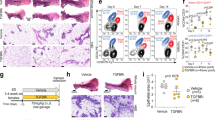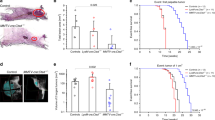Abstract
We previously showed that mice with a null mutation in syndecan-1 (Sdc1; CD138) were resistant to Wnt1-induced mammary tumor initiation. The absence of Sdc1 inhibited the increase in the mammary stem cell fraction that is characteristic of preneoplasia in this model. As the tumor precursor cells are recruited from the stem/progenitor cell compartment, tumor development was also inhibited (Liu et al., 2004; PNAS 101, 4158). Although Sdc1−/− mice are grossly normal, they are systemically smaller, suggesting that developmental abnormalities may extend further than their mammary glands. We have therefore evaluated the multi-organ response of Sdc1−/− mice to carcinogen-induced tumor development (7,12-dimethylbenz[a]anthracene, DMBA), and find these mice to be resistant to tumorigenesis in all the predominant carcinogen-susceptible lineages. Thus, Sdc1−/− mice administered DMBA during juvenile development are resistant not only to epithelial tumors, including liver (60–80%) and lung tumors (C57BL6 mice, 60–80%), but also to lymphoma (over 70%, depending upon strain and carcinogen dose). We demonstrate that CD138 is expressed (heterogeneously) in the hematopoietic stem cell fraction (and not only in pre-B and plasma cells), and that tumors arise in both myeloid and lymphoid lineages. Furthermore, carcinogen-induced mammary tumors are bilineal, implying a bipotent precursor cell. Both observations imply that the DMBA-induced tumor precursor cells are drawn from the stem/progenitor fraction, and we suggest that pathogenic activation of these cells could be abnormal in Sdc1−/− mice.
This is a preview of subscription content, access via your institution
Access options
Subscribe to this journal
Receive 50 print issues and online access
$259.00 per year
only $5.18 per issue
Buy this article
- Purchase on Springer Link
- Instant access to full article PDF
Prices may be subject to local taxes which are calculated during checkout







Similar content being viewed by others
Abbreviations
- Sdc1(CD138):
-
syndecan-1
- DMBA:
-
7,12-dimethylbenz[a]anthracene
- Ahr:
-
aryl hydrocarbon receptor
- MMTV:
-
mouse mammary tumor virus
- EROD:
-
ethoxyresorufin O-deethylase
- HSCs:
-
hematopoietic stem cells
- ENU:
-
N-ethyl-N-nitrosurea
References
Akamatsu Y . (1975). Neoplasms in strains of splenectomized mice after a single 7,12-dimethylbenz[alpha]anthracene treatment. J Natl Cancer Inst 55: 893–897.
Al-Hajj M, Wicha MS, Benito-Hernandez A, Morrison SJ, Clarke MF . (2003). Prospective identification of tumorigenic breast cancer cells. Proc Natl Acad Sci USA 100: 3983–3988.
Alexander CM, Reichsman F, Hinkes MT, Lincecum J, Becker KA, Cumberledge S et al. (2000). Syndecan-1 is required for Wnt-1-induced mammary tumorigenesis in mice. Nat Genet 25: 329–332.
Bernfield M, Gotte M, Park PW, Reizes O, Fitzgerald ML, Lincecum J et al. (1999). Functions of cell surface heparan sulfate proteoglycans. Annu Rev Biochem 68: 729–777.
Bunger MK, Moran SM, Glover E, Thomae TL, Lahvis GP, Lin BC et al. (2003). Resistance to 2,3,7,8-tetrachlorodibenzo-p-dioxin toxicity and abnormal liver development in mice carrying a mutation in the nuclear localization sequence of the aryl hydrocarbon receptor. J Biol Chem 278: 17767–17774.
Cardiff RD, Anver MR, Gusterson BA, Hennighausen L, Jensen RA, Merino MJ et al. (2000). The mammary pathology of genetically engineered mice: the consensus report and recommendations from the Annapolis meeting. Oncogene 19: 968–988.
Esko JD, Rostand KS, Weinke JL . (1988). Tumor formation dependent on proteoglycan biosynthesis. Science 241: 1092–1096.
Flaks A . (1968). The susceptibility of various strains of neonatal mice to the carcinogenic effects of 9,10-dimethyl-1,2-benzanthracene. Eur J Cancer 4: 579–585.
Forsberg EC, Prohaska SS, Katzman S, Heffner GC, Stuart JM, Weissman IL . (2005). Differential expression of novel potential regulators in hematopoietic stem cells. PLoS Genet 1: e28.
Gallo R, Kim C, Kokenyesi R, Adzick NS, Bernfield M . (1996). Syndecans-1 and -4 are induced during wound repair of neonatal but not fetal skin. J Invest Dermatol 107: 676–683.
Gotte M, Joussen AM, Klein C, Andre P, Wagner DD, Hinkes MT et al. (2002). Role of syndecan-1 in leukocyte–endothelial interactions in the ocular vasculature. Invest Ophthalmol Vis Sci 43: 1135–1141.
Heidel SM, MacWilliams PS, Baird WM, Dashwood WM, Buters JT, Gonzalez FJ et al. (2000). Cytochrome P4501B1 mediates induction of bone marrow cytotoxicity and preleukemia cells in mice treated with 7,12-dimethylbenz[a]anthracene. Cancer Res 60: 3454–3460.
Huntly BJ, Gilliland DG . (2005). Leukaemia stem cells and the evolution of cancer-stem-cell research. Nat Rev Cancer 5: 311–321.
Kenney NJ, Smith GH, Lawrence E, J.C B, Salomon DS . (2001). Identification of stem cell units in the terminal end bud and duct of the mouse mammary gland. J Biomed Biotechnol 1: 133–143.
Kramer KL, Yost HJ . (2003). Heparan sulfate core proteins in cell–cell signaling. Annu Rev Genet 37: 461–484.
Li Y, Welm B, Podsypanina K, Huang S, Chamorro M, Zhang X et al. (2003). Evidence that transgenes encoding components of the Wnt signaling pathway preferentially induced mammary cancers from progenitor cells. Proc Natl Acad Sci USA 100: 15853–15858.
Liu B, Kim Y-C, Leatherberry V, Cowin P, Alexander CM . (2003). Mammary gland development requires syndecan-1 to create a b-catenin/TCF-responsive mammary epithelial sub-population. Oncogene 22: 9243–9253.
Liu BY, McDermott SP, Khwaja SS, Alexander CM . (2004). The transforming activity of Wnt effectors correlates with their ability to induce the accumulation of mammary progenitor cells. Proc Natl Acad Sci USA 101: 4158–4163.
Maeda T, Alexander CM, Friedl A . (2004). Induction of syndecan-1 expression in stromal fibroblasts promotes proliferation of human breast cancer cells. Cancer Res 64: 612–621.
Maeda T, Desouky J, Friedl A . (2006). Syndecan-1 expression by stromal fibroblasts promotes breast carcinoma growth in vivo and stimulates tumor angiogenesis. Oncogene 25: 1408–1412.
Mehta RG . (2000). Experimental basis for the prevention of breast cancer. Eur J Cancer 36: 1275–1282.
Morrison SJ, Weissman IL . (1994). The long-term repopulating subset of hematopoietic stem cells is deterministic and isolatable by phenotype. Immunity 1: 661–673.
Nikitin AY, Alcaraz A, Anver MR, Bronson RT, Cardiff RD, Dixon D et al. (2004). Classification of proliferative pulmonary lesions of the mouse: recommendations of the mouse models of human cancers consortium. Cancer Res 64: 2307–2316.
Paguirigan A, Beebe DJ, Liu B, Alexander C . (2006). Mammary stem and progenitor cells: tumor precursors? Eur J Cancer 42: 1225–1236.
Park PW, Pier GB, Hinkes MT, Bernfield M . (2001). Exploitation of syndecan-1 shedding by Pseudomonas aeruginosa enhances virulence. Nature 411: 98–102.
Ranheim EA, Kwan HC, Reya T, Wang YK, Weissman IL, Francke U . (2005). Frizzled 9 knock-out mice have abnormal B-cell development. Blood 105: 2487–2494.
Roe FJ, Walters MA . (1968). Sensitivity of newborn mice to carcinogenic agents. Food Cosmet Toxicol 6: 581–582.
Shackleford G, MacArthur C, Kwan H, Varmus H . (1993). Mouse mammary tumor virus infection accelerates mammary carcinogenesis in Wnt-1 transgenic mice by insertional activation of int-2/Fgf-3 and hst/Fgf- 4. Proc Natl Acad Sci USA 90: 740–744.
Shackleford GM, Varmus HE . (1988). Construction of a clonable, infectious, and tumorigenic mouse mammary tumor virus provirus and a derivative genetic vector. Proc Natl Acad Sci USA 85: 9655–9659.
Singh SK, Clarke ID, Terasaki M, Bonn VE, Hawkins C, Squire J et al. (2003). Identification of a cancer stem cell in human brain tumors. Cancer Res 63: 5821–5828.
Singh SK, Hawkins C, Clarke ID, Squire JA, Bayani J, Hide T et al. (2004). Identification of human brain tumour initiating cells. Nature 432: 396–401.
Stepp MA, Gibson HE, Gala PH, Iglesia DD, Pajoohesh-Ganji A, Pal-Ghosh S et al. (2002). Defects in keratinocyte activation during wound healing in the syndecan-1-deficient mouse. J Cell Sci 115: 4517–4531.
Sutherland AE, Sanderson RD, Mayes M, Seibert M, Calarco PG, Bernfield M et al. (1991). Expression of syndecan, a putative low affinity fibroblast growth factor receptor, in the early mouse embryo. Development 113: 339–351.
Taylor KR, Gallo RL . (2006). Glycosaminoglycans and their proteoglycans: host-associated molecular patterns for initiation and modulation of inflammation. FASEB J 20: 9–22.
van Leeuwen F, Nusse R . (1995). Oncogene activation and oncogene cooperation in MMTV-induced mouse mammary cancer. Semin Cancer Biol 6: 127–133.
Walters MA . (1966). The induction of lung tumours by the injection of 9,10-dimethyl-1,2-benzanthracene (DMBA) into newborn suckling and young adult mice. A dose response study. Br J Cancer 20: 148–160.
Whitelock JM, Iozzo RV . (2005). Heparan sulfate: a complex polymer charged with biological activity. Chem Rev 105: 2745–2764.
Acknowledgements
We thank Dr Henry Pitot (McArdle Laboratory, UW-Madison) for histological analysis of liver tumors; Dr Norman Drinkwater (McArdle Laboratory) for help with statistical analyses; Jane Weeks and Harlene Edwards at the McArdle Histology core; Joel Puchalski and Kathy Schell at the UW Flow Facility for their expertise; members of Dr Chris Bradfield's lab (McArdle Laboratory) for help with the EROD assay; Kelly Moore and Melissa Mastroianni for assistance with genotyping and immunohistochemical staining; Tianxing Liu for maintenance of our mouse colonies; and members of the Alexander lab for helpful discussions. This study was supported by the National Institutes of Health (CA 90877), the Susan Komen Foundation (BCTR 0202106) and the UW Cancer Center and the Cancer Biology Training Program (SPM; T32 CA09135).
Author information
Authors and Affiliations
Corresponding author
Additional information
Supplementary Information accompanies the paper on oncogene website (http://www.nature.com/onc).
Supplementary information
Rights and permissions
About this article
Cite this article
McDermott, S., Ranheim, E., Leatherberry, V. et al. Juvenile syndecan-1 null mice are protected from carcinogen-induced tumor development. Oncogene 26, 1407–1416 (2007). https://doi.org/10.1038/sj.onc.1209930
Received:
Revised:
Accepted:
Published:
Issue Date:
DOI: https://doi.org/10.1038/sj.onc.1209930
Keywords
This article is cited by
-
Syndecan-1 induction in lung microenvironment supports the establishment of breast tumor metastases
Breast Cancer Research (2018)
-
Syndecan-1 is a novel molecular marker for triple negative inflammatory breast cancer and modulates the cancer stem cell phenotype via the IL-6/STAT3, Notch and EGFR signaling pathways
Molecular Cancer (2017)
-
Enhanced efficacy and specificity of epithelial ovarian carcinogenesis by embedding a DMBA-coated cloth strip in the ovary of rat
Journal of Ovarian Research (2012)
-
Antithetic roles of proteoglycans in cancer
Cellular and Molecular Life Sciences (2012)
-
Mechanisms by Which the Extracellular Matrix and Integrin Signaling Act to Regulate the Switch Between Tumor Suppression and Tumor Promotion
Journal of Mammary Gland Biology and Neoplasia (2011)



